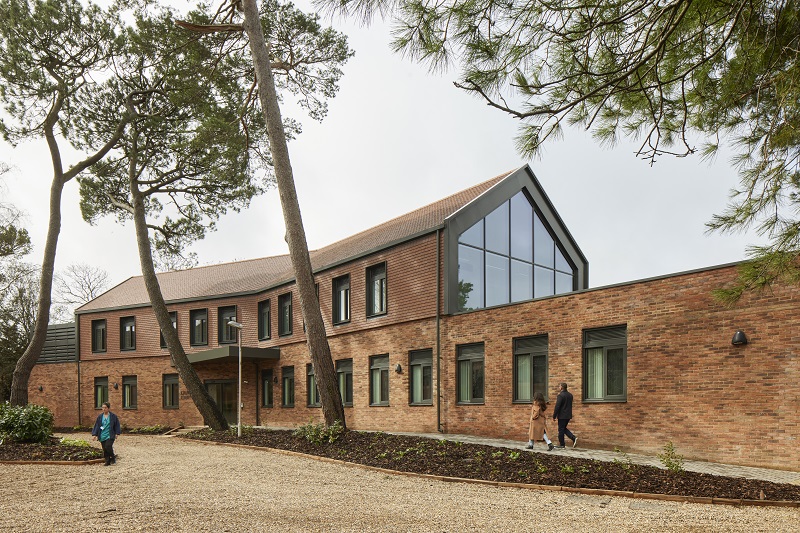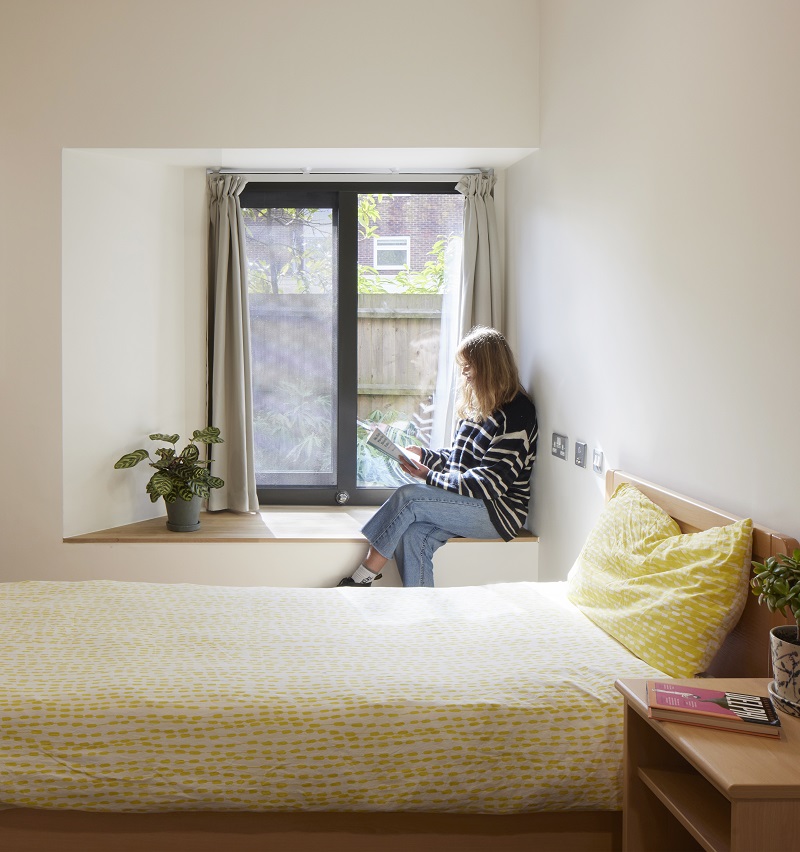Sited in a protected wooded glade, Kimmeridge Court has been carefully crafted to preserve the quality of its natural setting and to create a uniquely-private and therapeutic environment for the treatment of patients with eating disorders.
Designed by Medical Architecture and built by Kier for Dorset HealthCare University NHS Foundation Trust, the £8m inpatient unit at St Ann’s Hospital in Poole, provides specialist accommodation to meet a growing demand for services.
Eating disorders are responsible for more loss of life than any other mental health condition and are becoming increasingly common in the UK and worldwide.
In England, hospital admissions for eating disorders reached over 24,000 in 2020-2021, a five-year increase of 84%.
And, in Dorset, the All Age Eating Disorders Service has seen a year-on-year increase and a significant surge during the COVID-19 pandemic – by 53% from 2020/2021 to 2021/2022.
Bed shortages
While nationally there is a shortfall in available beds for eating disorders, the completion of Kimmeridge Court will increase the trust’s capacity for specialist care from 6 to 10 beds, ensuring patients can receive treatment closer to home and their support network; a factor that aids recovery.
“Treatment for eating disorders can be notoriously difficult, with patients often reluctant to receive effective care,” said Bob Wills, director at Medical Architecture.
“This can lead to covert interference behaviours to ‘sabotage’ treatment, such as overactivity, self-induced vomiting, and weight falsification.
By integrating the building so closely with its natural setting we have been able to fully harness the therapeutic quality of this fantastic site
“To manage these behaviours, staff observation of patients is a critical factor of successful treatment.
“However, it can be a challenge to achieve this while still protecting the privacy and dignity of patients.
“Offering expanded and improved facilities, including inpatient bedrooms, clinical, and therapy spaces, and sensitively-designed living spaces, the new building addresses these challenges, providing a supportive environment for patient recovery.”

The development is set in mature woodland within the grounds of the Grade II-listed St Ann's Hospital

The development is set in mature woodland within the grounds of the Grade II-listed St Ann's Hospital
A sensitive site
The building is located within the grounds of the Grade II-listed St Ann’s Hospital on the Dorset coast, near to Sandbanks.
The size and positioning of the building has been carefully crafted to have a low impact on the mature coastal trees that occupy the site and to respect the character of the surrounding area.
And the larger two-storey volume of the building is set back from the site boundary and adjoining road, reducing in scale to single storey as it approaches the street frontage.
An irrigated root-protecting foundation design lifts the building above the roots of the large mature Category A trees, which enabled their retention remarkably close to the new building.
“The design’s response to the site context plays a vital role in the creation of a comfortable and non-clinical environment which supports recovery and provides patients with a sense that they are valued and deserving of care,” explains Wills.
“The bedroom accommodation and patient day spaces are located together on the ground floor, providing eight inpatient beds and two high dependency beds.
“The transparent day spaces have views out to an accessible landscaped garden and the surrounding woodland, maximising the therapeutic benefit.
“And staff and therapy rooms occupy the first floor, with a large multi-functional activity space providing spectacular views out across the tree canopy.”
Bedroom accommodation is sited on the ground floor
Supportive spaces
Through close consultation with clinical staff, the facilities at Kimmeridge Court have been designed to enable patients to re-establish a positive relationship with food and exercise.
For example, an attractive and homely Activities of Daily Living (ADL) kitchen area allows patients to practice meal preparation and cooking in an environment that mirrors everyday life.
And group therapy spaces are immediately accessible from the dining space to enable workshops to take place, in which feelings about eating are shared and explored.
Sliding doors allow these key shared spaces to be opened up to promote social connection, or separated for more-private, focused activity.
While a private outdoor garden has been provided as a therapeutic space, it has been designed to limit opportunities for excessive exercise, a common treatment interference behaviour.
If a patient’s treatment requires access to the outside space to be restricted, large areas of glazing provide expansive views to the garden from the lounge and the activity room, to maintain a connection with the outdoors.
Non-intrusive observation
Wills said: “Working closely with the trust we have designed a place where patients can recover in an environment conducive to recovery-focused and high-quality care.
“By integrating the building so closely with its natural setting we have been able to fully harness the therapeutic quality of this fantastic site.”
Due to the restful nature of their treatment, patients are encouraged to spend time in their bedrooms. As a result, they have been designed to be a comfortable space for relaxation and reflection.
Bay windows provide a place to sit and enjoy the trees of the wooded glade while bringing light deep into the room.
And the layout of the bedrooms, and the ward plan with a central staff base, allows observation to be maintained with efficient staffing levels, without patients feeling their privacy has been compromised.
Furthermore, generous corridors are designed as an additional room, providing informal places to sit, rest, and chat with other patients and the clinical team.
This is enhanced by careful location of rooflights to assist placemaking along circulation routes and within the staff base.
Anti-ligature measures have been thoughtfully and discreetly integrated throughout to create a calming environment resembling a domestic setting.
And natural materials and neutral colours throughout the building interior complement the ever-present views to nature, with large areas of glazing and rooflights providing natural light to reinforce circadian rhythms and reduce the requirement for internal lighting.
Protecting and respecting
Externally, the design uses traditional materials found on the hospital site, such as brick and clay roof tiles, but details them in a contemporary manner, providing a modern and attractive setting for the treatment and care of vulnerable patients.
The external landscaping around the building is permeable and designed to reduce surface runoff, retaining as much rainwater on the site as possible. This is to irrigate the existing and newly-planted trees and shrubs, while mitigating any local flood risk at times of extremely high rainfall.
With the expanded capacity, fewer of our patients will need to receive care away from their support systems, their family, and their community teams, and this will have such a positive impact on recovery
And the extensive canopies of the retained mature trees provide good shade and shelter from extreme future climate effects.
Dr Carla Figueiredo, consultant psychiatrist at Dorset HealthCare University NHS Foundation Trust, said: “We’ve been long awaiting a modern, fit-for-purpose building, and now we have it — it’s beautiful.
“With the expanded capacity, fewer of our patients will need to receive care away from their support systems, their family, and their community teams, and this will have such a positive impact on recovery.
“I've looked at other units around the country and what we have created here makes me very proud.”
Jess Griffiths, an eating disorders therapist and former eating disorders service user at St Ann’s Hospital, adds: “As soon as I walked into the new building, I actually welled up.
“I was so emotional because it is so beautiful, and it’s going to help so many people in their treatment.
“I think the environment will facilitate so many more therapeutic activities, like supported eating and all the things you need to increase your chances of recovery.”

